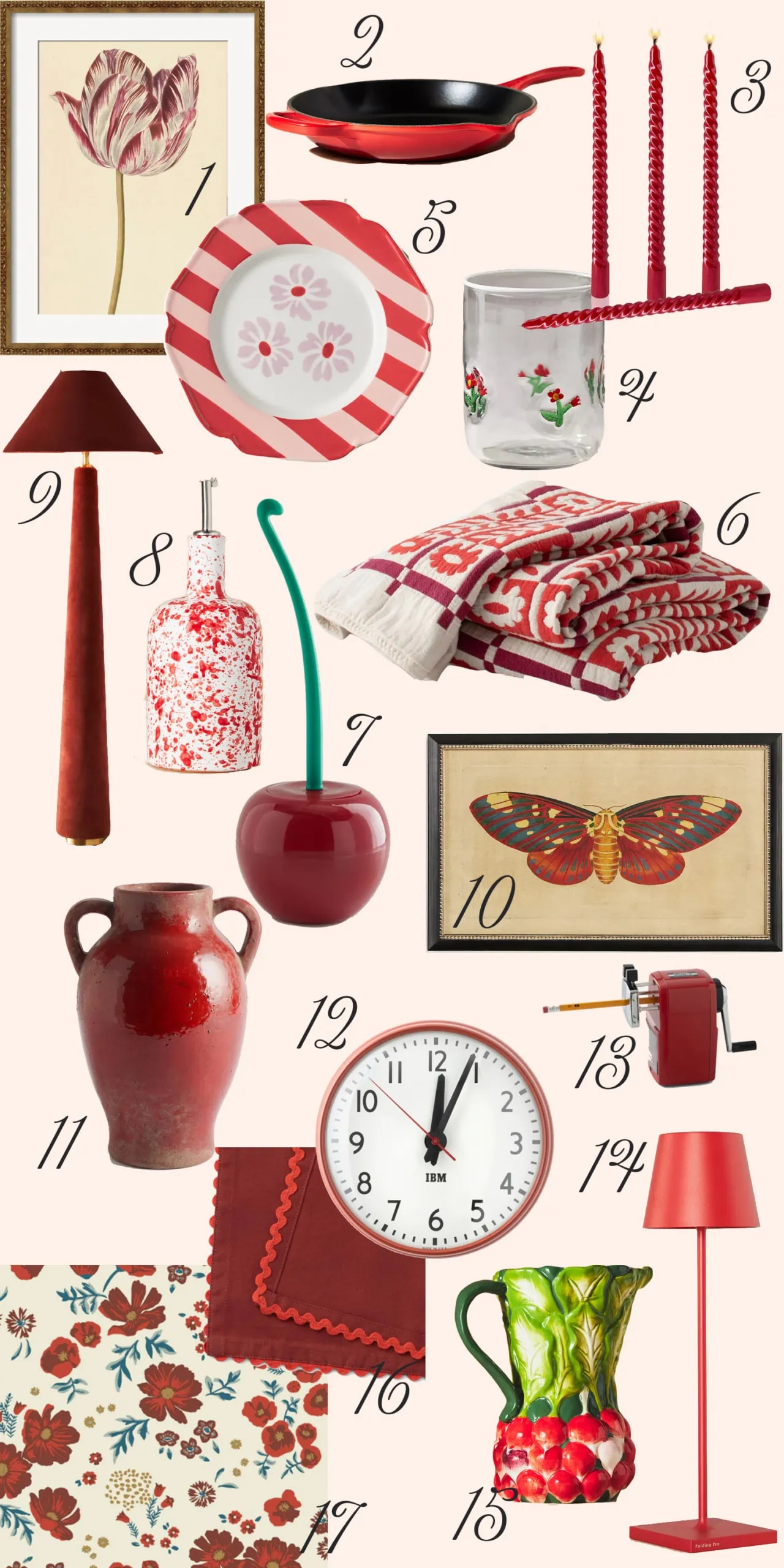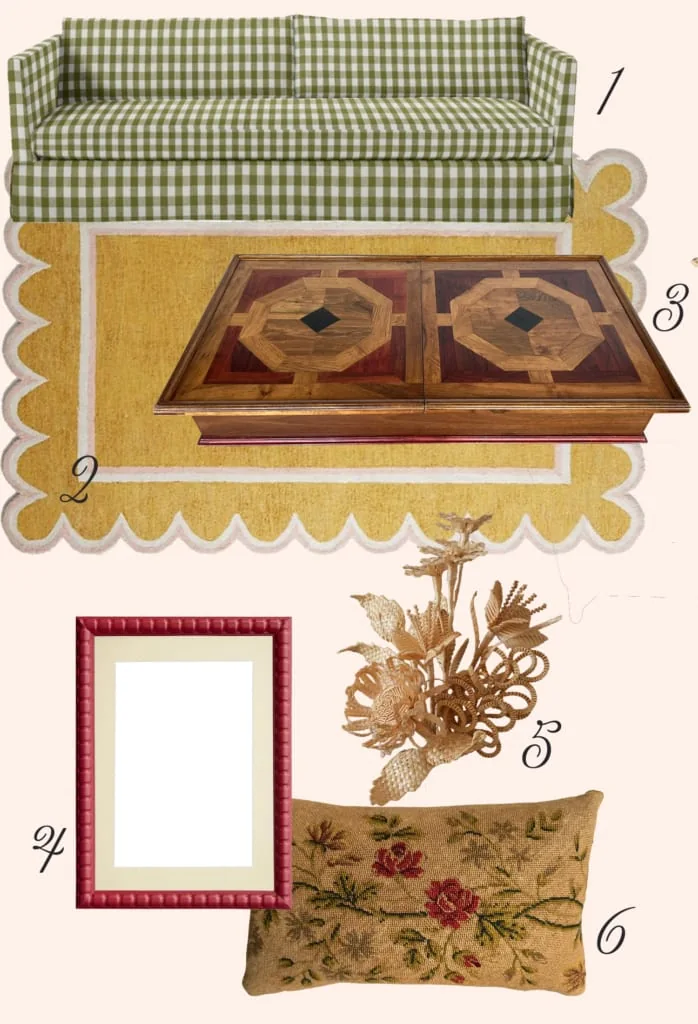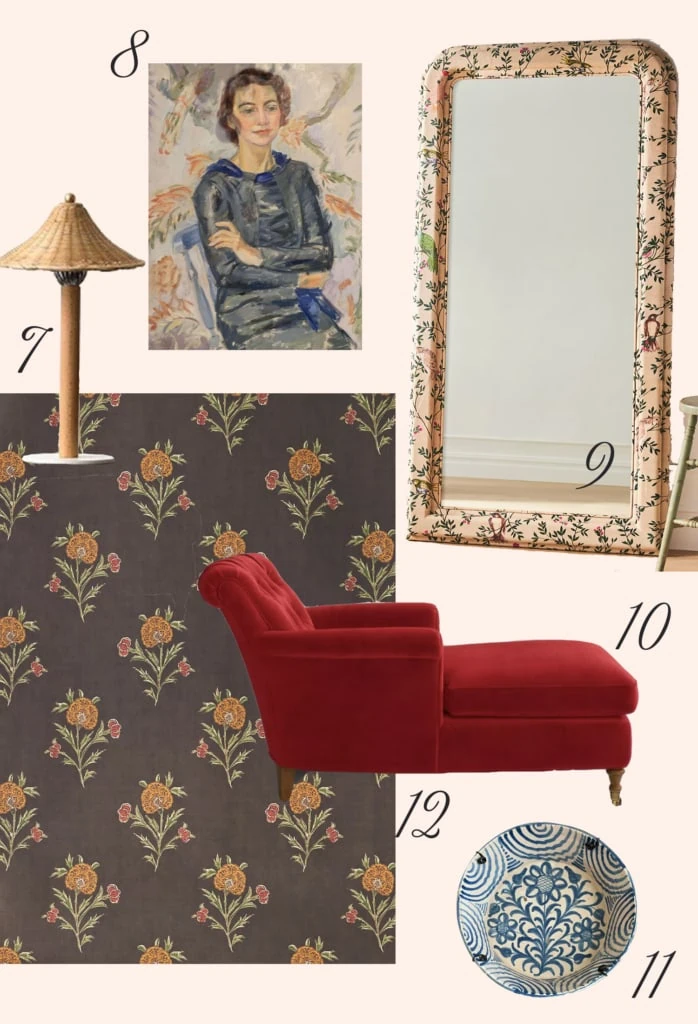Have you noticed the unexpected red theory going around social media right now? It’s a theory that has persisted through time that basically proposes that a dash of red here and there will always settle a room. I absolutely believe this! In fact, I started building this living room collage above as my monthly “Somebody make this room happen” series (see the cottagecore one here). Then I started thinking about the unexpected red theory, added some in and boom, it’s just what the doctor ordered!
Get the look of this living room!
- Green checkered sofa
- Yellow scalloped rug
- French vintage wood coffee table
- Red bobbin frame
- Straw flowers
- Antique Italian Florentine pillow
- Rattan desk lamp
- Vintage painting, Swedish artist, portrait of a woman
- Floral floor length mirror
- Red lounge chair
- Antique Spanish plate
- Floral wallpaper
I added in the red chaise lounge as a complement to the green sofa as well as the red-toned coffee table in the wood, and the red frame.
Red items to add to your home
Next, I took it as a challenge to find other red things to add to your home and I found some true delights.

- red tulip print
- Red skillet (I have this in pink one and use it all the time!)
- Red taper candles
- Red floral glass
- Red striped floral plate
- Red floral quilt (adore this!)
- Cherry toilet brush holder (can you believe it?!)
- Olive oil canister
- Red floor lamp
- Red butterfly art
- Red vessel
- Red IBM clock
- Red pencil sharpener
- Red desk lamp
- Red radish pitcher
- Red scallop napkins
- Red floral wallpaper
But, what IS the Unexpected Red Theory?
Red, a color often associated with passion, energy, and vitality, holds a special place in the realm of design. While it’s often used as an accent or statement piece, the Unexpected Red Theory takes this a step further, advocating for its incorporation in unexpected and unconventional ways within interior spaces.
Why use the theory?
At first glance, the idea of infusing red into an interior might seem daunting or even risky. After all, red is a bold color that can easily overwhelm if not used thoughtfully. However, proponents of the Unexpected Red Theory argue that when applied with intention and creativity, red has the power to transform a space in ways that are both surprising and captivating.
What are the benefits of using red?
One of the key principles of the Unexpected Red Theory is its ability to create focal points within a room. Just as a pop of red in a black-and-white photograph can draw the eye and add visual interest, strategically placed red elements in an interior can command attention and inject a sense of drama. Whether it’s a vibrant red accent wall, a bold piece of furniture, or even just a few carefully chosen accessories, the presence of red immediately enlivens the space and creates a dynamic focal point.
Red has the remarkable ability to evoke emotions and set the tone for a space. In a dining room, for example, deep shades of red can stimulate the appetite and create a warm, inviting atmosphere perfect for entertaining guests. In a study or home office, brighter shades of red can promote concentration and productivity, making it an ideal choice for those seeking to create a stimulating work environment. By harnessing the psychological power of color, the Unexpected Red Theory allows designers to tailor spaces to suit specific moods and functions.
But perhaps the most intriguing aspect of the Unexpected Red Theory is its versatility. Contrary to popular belief, red can be incorporated into virtually any design style, from sleek and modern to rustic and traditional. I even call it a neutral! In a minimalist setting, a single red statement piece can add a much-needed pop of color and personality, while in a more eclectic space, red can be layered with other bold hues for a playful, eclectic vibe. Whether used sparingly or in abundance, red has a transformative effect that transcends design boundaries, making it a valuable tool for designers seeking to push the envelope and create truly memorable spaces.
Of course, like any design theory, the key to successfully implementing the Unexpected Red Theory lies in balance and restraint. While red can undoubtedly make a powerful statement, overdoing it can lead to visual overload and detract from the overall harmony of a space. Instead, designers must carefully consider factors such as scale, proportion, and the surrounding color palette to ensure that red is used in a way that enhances rather than overwhelms the space.
The Unexpected Red Theory challenges conventional wisdom and encourages designers to embrace the bold and unexpected. By harnessing the power of red, designers can create spaces that are not only visually stunning but also emotionally engaging and deeply memorable. Whether used as a focal point or a subtle accent, red has the ability to breathe new life into interiors and elevate them to new heights of style and sophistication. So the next time you find yourself pondering a design dilemma, consider embracing the Unexpected Red Theory – you might just be surprised at the transformative impact it can have.
Wrote the book about color
All that said–did you know that I wrote a book about color? Yup! It’s called Craft the Rainbow. You can find it here!
Have you tried the red theory out in your own home?




